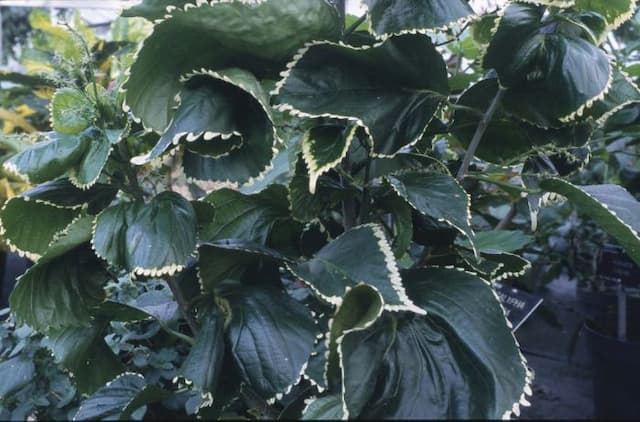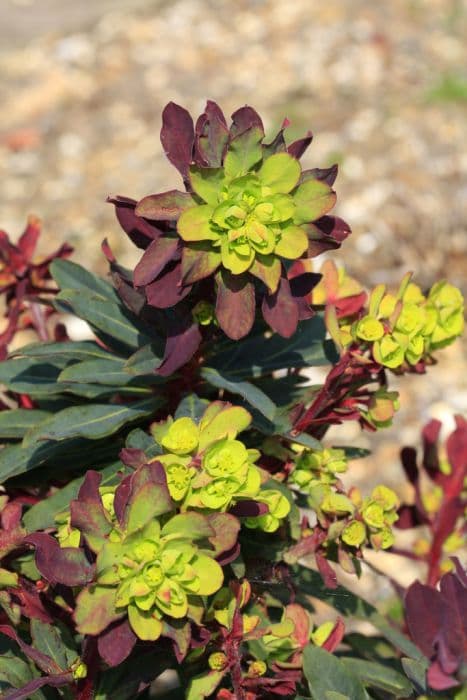Spurge Euphorbia × pasteurii 'Roundway Titan'

ABOUT
Euphorbia × pasteurii 'Roundway Titan', commonly known as spurge, is an attractive perennial plant. The plant showcases an elegant structure with a bushy, mounding form. Its foliage is distinctive, consisting of oblong leaves that are arranged spirally around the stems, creating a lush and dense appearance. The leaves are a bright green color, which contrasts well with the flower heads it produces. The spurge blooms during the spring and early summer, offering a display of small, inconspicuous flowers that are actually specialized structures called cyathia. The flower heads are a combination of bracts which are modified leaves, often taking on a yellowish or chartreuse color, adding a striking visual interest during their blooming season. These bracts surround the true flowers which are tiny and not particularly noticeable without close inspection. This variety of spurge, 'Roundway Titan,' has an attractive, rounded habit, with its foliage creating a dense and full appearance, making it a visually appealing centerpiece in a garden or mixed border. Its resilient nature combined with its decorative look makes it a favorable choice for gardeners who desire a low-maintenance yet aesthetically pleasing plant.
About this plant
 Names
NamesFamily
Euphorbiaceae
Synonyms
Pasture Spurge, Titan Spurge
Common names
Euphorbia × pasteurii 'Roundway Titan'.
 Toxicity
ToxicityTo humans
The spurge is toxic to humans due to the presence of a milky sap, which contains compounds that can cause skin and eye irritation upon contact. If ingested, the toxic principles in the sap can cause severe gastrointestinal distress, including symptoms like nausea, vomiting, diarrhea, and stomach pain. In rare cases, more severe reactions may occur such as difficulty swallowing, swelling of the mouth or throat, or extensive damage to the digestive tract. Therefore, it is important to exercise caution and prevent ingestion of any part of the spurge plant.
To pets
The spurge is also toxic to pets. The milky sap contains irritant chemicals that can cause symptoms such as drooling, vomiting, and diarrhea if ingested. Additionally, if pets come into contact with the sap, it can lead to skin and eye irritation. Ingesting any part of the spurge plant can be harmful and if a pet is suspected of consuming it, veterinary attention should be sought promptly.
 Characteristics
CharacteristicsLife cycle
Perennials
Foliage type
Evergreen
Color of leaves
Green
Flower color
Yellow
Height
4 feet (1.2 meters)
Spread
4 feet (1.2 meters)
Plant type
Shrub
Hardiness zones
7
Native area
Hybrid
Benefits
 General Benefits
General Benefits- Easy to Grow: The Euphorbia × pasteurii 'Roundway Titan' is known for being hardy and tolerant of a variety of conditions, making it easy for gardeners of all levels to grow.
- Drought Tolerant: Once established, it is highly resistant to drought, reducing the need for frequent watering.
- Long-Lasting Color: The plant produces attractive, long-lasting flowers and bracts that add color to gardens throughout the growing season.
- Architectural Interest: With its upright form and structure, 'Roundway Titan' adds visual interest and can serve as a focal point in garden designs.
- Pest Resistant: It is relatively resistant to pests and diseases, minimizing the need for chemical treatments.
- Low Maintenance: Requires minimal care beyond the occasional pruning to maintain shape and remove spent flowers.
- Attracts Pollinators: The flowers attract pollinators such as bees and butterflies, supporting biodiversity in the garden.
- Adaptable: It can thrive in a variety of soil types as long as they are well-drained.
- Evergreen Foliage: In milder climates, 'Roundway Titan' maintains its foliage throughout the year, providing continuous interest.
- Multiseasonal Interest: Provides visual interest across multiple seasons with its evergreen foliage, colorful bracts, and architectural form.
 Medical Properties
Medical PropertiesThis plant is not used for medical purposes.
 Air-purifying Qualities
Air-purifying QualitiesThis plant is not specifically known for air purifying qualities.
 Other Uses
Other Uses- Euphorbia × pasteurii 'Roundway Titan', known commonly as spurge, can be used as a natural dye for fabrics, giving a yellow to brownish color depending on the mordant used.
- The sap of spurge, due to its toxic properties, can be used as a natural deterrent for pests like rabbits and deer in the garden.
- With its sturdy stems and architectural shape, spurge can be incorporated into flower arrangements for added texture and interest.
- The plant can serve as a model organism for studies on drought resistance, due to its ability to thrive in dry conditions.
- Spurge can be used as a living mulch to suppress weeds and conserve soil moisture in garden beds.
- As it exudes a milky sap when cut, children have historically used spurge stems as a rudimentary form of 'nature's glue' for minor repairs or crafts.
- Its low maintenance and drought-tolerant attributes make spurge an excellent choice for xeriscaping, helping reduce the need for irrigation in landscaping.
- In coastal areas, spurge can play a role in stabilizing sand dunes due to its robust root systems.
- The distinctive geometric patterns of spurge can inspire artists and designers for creating naturalistic motifs in art and textile designs.
- The robust nature of spurge allows it to be used in horticultural therapy programs where participants may not have a high level of gardening skills but can still enjoy successful gardening experiences.
Interesting Facts
 Feng Shui
Feng ShuiSpurge is not used in Feng Shui practice.
 Zodiac Sign Compitability
Zodiac Sign CompitabilitySpurge is not used in astrology practice.
 Plant Symbolism
Plant Symbolism- Strength: The robust structure of the Euphorbia × pasteurii 'Roundway Titan', commonly known as Spurge, reflects an embodiment of strength and resilience, making it symbolic of an individual's inner power and ability to overcome obstacles.
- Determination: Spurge is a plant that can thrive in tough conditions, which symbolizes a persistent determination to succeed, regardless of challenges faced.
- Protection: With its toxic sap and often spiky appearance, Spurge is thought to symbolize protection, warding off negative influences and providing a barrier against harm.
- Healing: Historically, certain euphorbias have been used in traditional medicine. The Spurge symbolizes healing and the alleviation of pain, hinting at its potential medicinal properties.
 Water
WaterSpurge 'Roundway Titan' prefers consistent moisture but does not like to be waterlogged. Watering once a week with approximately 1 gallon of water per plant should suffice, but this can vary depending on temperature and soil moisture levels. During hot, dry spells, the plant may need more frequent watering, possibly twice a week. Conversely, in cool, damp weather, watering may only be necessary every other week. Ensure the soil is well-draining and water at the base of the plant to avoid wetting the foliage, which can lead to fungal diseases.
 Light
LightSpurge 'Roundway Titan' thrives in full sun to partial shade conditions. The ideal spot for this plant is an area that receives at least 4 to 6 hours of direct sunlight daily, complemented with dappled or filtered sunlight for the remaining day. Avoid deep shade locations, as this can impede the plant's growth and flowering potential.
 Temperature
TemperatureSpurge 'Roundway Titan' is hardy in a range of temperatures and can tolerate a minimum of around 10°F to a maximum of around 90°F. However, it grows best in temperate climates where the temperatures are consistently between 60°F and 75°F. Protect the plant from extreme cold by providing mulch or shelter if temperatures drop below its minimum tolerance.
 Pruning
PruningPruning Spurge 'Roundway Titan' is essential to maintain its shape and encourage a bushy growth habit. Prune in late winter or early spring before new growth starts, by cutting back any leggy or damaged stems. Deadheading spent flowers can also promote further blooming. This plant may benefit from gentle pruning 1 to 2 times a year to remove old wood and stimulate new foliage.
 Cleaning
CleaningAs needed
 Soil
SoilThe Spurge ‘Roundway Titan’ prefers a well-draining soil mix with a slightly acidic to neutral pH between 6.0 and 7.0. A mixture of potting soil, coarse sand, and peat or compost would be ideal. Ensure that the soil allows for good aeration and drainage to prevent root rot.
 Repotting
RepottingSpurge ‘Roundway Titan’ should be repotted every 2-3 years or when it outgrows its current pot. Spring is the best time for repotting to encourage growth during the active season.
 Humidity & Misting
Humidity & MistingSpurge ‘Roundway Titan’ is tolerant of a wide range of humidity levels but prefers moderate humidity. It does not require high humidity and can thrive in the typical humidity levels found in most homes.
 Suitable locations
Suitable locationsIndoor
Place in bright, indirect light and ensure good airflow.
Outdoor
Plant in sun to part shade and protect from harsh winds.
Hardiness zone
7-10 USDA
 Life cycle
Life cycleThe Euphorbia × pasteurii 'Roundway Titan', commonly known as Spurge, begins its life cycle with seed germination, which requires warm temperatures and adequate moisture. After germination, it enters the seedling stage, where it develops its first true leaves and establishes a root system. As it grows, Spurge transitions into the vegetative stage, where it develops a sturdy stem and a larger leaf area for photosynthesis. It then enters the flowering stage, usually in late spring or early summer, when it produces its characteristic inflorescence with small yellow-green flowers surrounded by long-lasting bracts. After pollination, the plant produces seeds which mature and are released into the environment to start a new cycle. Spurge is a perennial plant, meaning it can live for several years, going through cycles of dormancy in the winter and regrowth in the warmer months.
 Propogation
PropogationPropogation time
Spring to Summer
The most popular method of propagation for Euphorbia × pasteurii 'Roundway Titan', commonly known as Spurge, is by cuttings. This is typically done in the spring or early summer when the plant is actively growing. You should select healthy, non-flowering stems for the best results. Using a clean, sharp cutting tool, cut a stem that is about 4 to 6 inches (10 to 15 cm) long, making sure there are several leaves on the cutting. The cut end can be dipped in rooting hormone to encourage root development, although this is not strictly necessary. The cutting should then be placed in a pot with well-draining soil, watering it lightly. It's important to keep the soil moist but not soggy, and to provide the cutting with bright, indirect light until roots have formed, after which it can be transplanted to its permanent location.



![Spurge [Blackbird]](/_next/image?url=https%3A%2F%2Fplants-admin.emdemapps.com%2Fimages%2Fplants%2F%2Fimages%2F604b535f37783.png&w=640&q=75)





